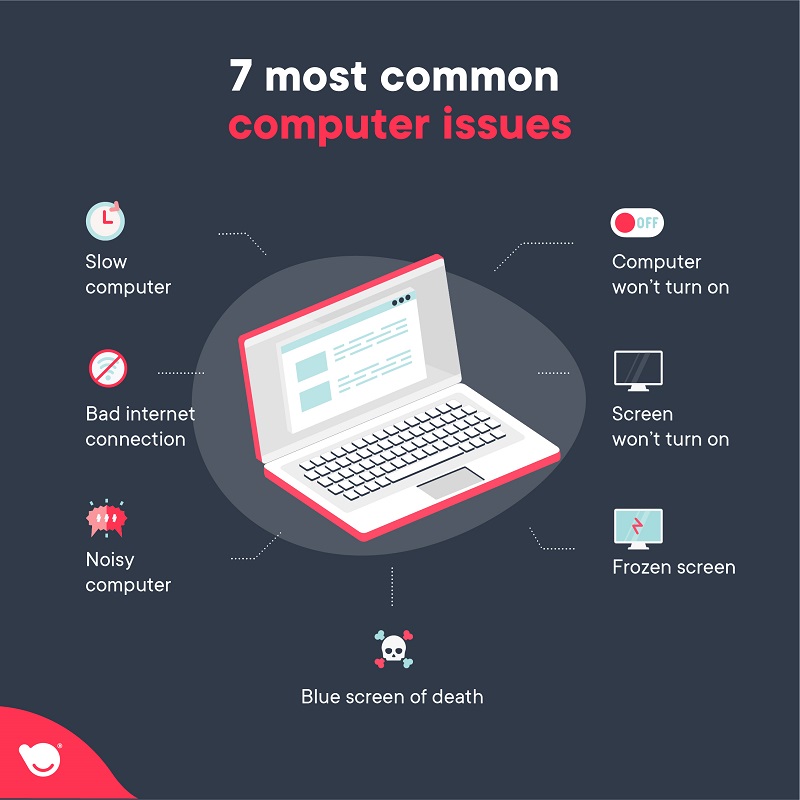Common Computer Issues and Efficient Solutions
Computers play a vital role in our everyday activities, whether for professional tasks, educational purposes, or leisure activities. However, they may occasionally face problems that impede their performance. The positive aspect is that many prevalent computer issues have straightforward resolutions that can be implemented prior to seeking professional assistance. In this article, we will examine some of the most common problems and provide quick solutions for them.
1. Decreased Performance
A slow computer is among the most frequent grievances. It can be exasperating when your device takes an extended time to load applications or respond to commands.
Cause:
Excessive background applications running simultaneously.
Fragmented hard drive or insufficient disk space.
Infection by malware or viruses.
Solution:
Close unneeded applications using Task Manager (Ctrl + Shift + Esc).
Utilize the built-in Disk Cleanup utility or reliable third-party software to free up disk space.
Conduct a comprehensive system scan with a reputable antivirus program to eliminate potential threats.
2. Overheating Issues
Overheating can result in unexpected system shutdowns and potentially damage internal components if not properly managed.
Cause:
Accumulation of dust obstructing air vents and cooling fans.
Insufficient cooling mechanisms or inadequate airflow.
Solution:
Use compressed air to clean the air vents and cooling fans.
Position your computer on a flat, hard surface to enhance ventilation.
Consider acquiring a cooling pad for laptops.
3. Software Failures
Frequent crashes of applications can interrupt work and lead to data loss.
Cause:
Outdated software versions or incompatibility with the system.
Corrupted installation files.
Solution:
Update the software to its latest version.
Uninstall and reinstall the problematic software.
Check for updates to your operating system to enhance compatibility.
4. Wi-Fi Connectivity Challenges
Experiencing internet connectivity issues can be highly disruptive, particularly when relying on it for work or academic activities.
Cause:
Temporary network malfunctions or outdated drivers.
Incorrect network configurations.
Solution:
Restart your router and modem.
Update your network adapter drivers through Device Manager.
Reset network configurations by using the Windows Network Troubleshooter.
5. Blue Screen of Death (BSOD)
The feared BSOD can be concerning, often indicating a serious system error.
Cause:
Hardware malfunctions or incompatible device drivers.
Corrupted system files.
Solution:
Record the error code displayed on the BSOD and search for its interpretation online.
Update or reinstall device drivers.
Run diagnostic tools, such as Windows Memory Diagnostic, to identify hardware issues.
Preventative Strategies
Maintaining your computer can significantly reduce the chances of encountering these problems:
Keep your operating system, drivers, and applications updated.
Regularly clean your computer’s hardware to avoid dust accumulation.
Utilize reliable antivirus software and refrain from clicking on suspicious links or downloading unknown files.
Frequently back up your data to prevent potential loss of important files in the event of a system crash.
Conclusion
While many computer problems can be addressed through basic troubleshooting, certain issues may require the expertise of a professional. If you have attempted these solutions and continue to experience difficulties, do not hesitate to contact a trusted computer repair specialist. Regular upkeep and prompt action can help ensure your system operates efficiently for years to come.


Comments
No comments yet.
Leave a Comment